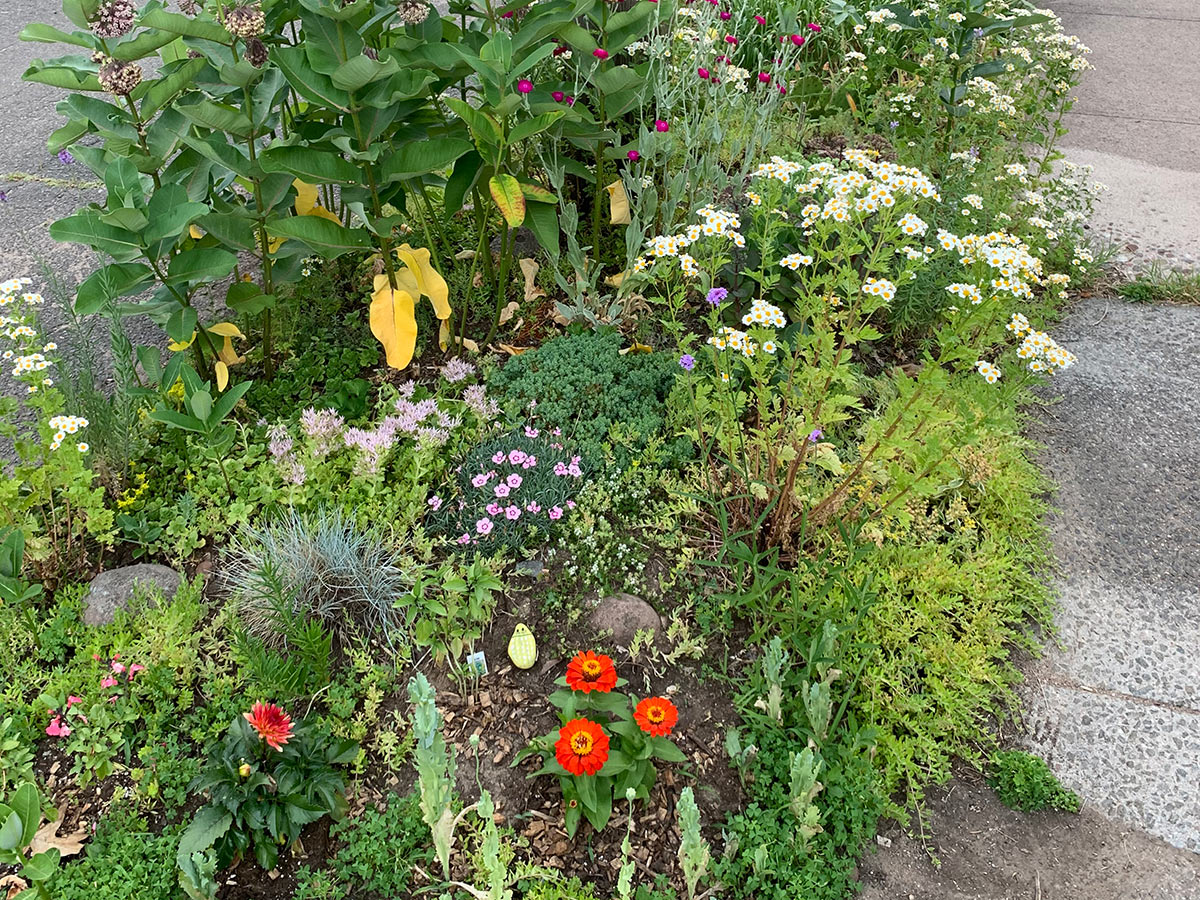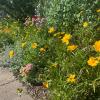At age 36, I learned to stop and smell the flowers. One day while walking with my toddler she became transfixed by goldenrod flowers right at eye and nose level. She leaned in and took a deep breath. Seeing her huge smile, I bent down to join her and discovered what I’d been missing.
From that point on we always stopped to smell the flowers. Over time, we started noticing how the flowering plants in a yard defined what insect life we’d see. Lavender was often covered in honey bees or wool carder bees with their distinctive, sharp angled flying style. The California poppies attracted bumble bees that appeared to roll around in the flower to collect pollen. And, of course the yards with very little plant diversity — or the appearance of high pesticide use — generally were silent with no buzzing to enjoy.

To bring back the pollinators, ditch the pesticides
As the pesticide program director, I help people achieve the third goal of the Xerces Society’s Bring Back the Pollinators Pledge and NOT reach for a jug or spray can when they see some unwanted insect, weed or other “pest.” Currently, buying pesticides — whether that be insecticides, herbicides, fungicides or other pesticides — is the go-to option for many home gardeners if they suspect they have pests. More than $3 billion dollars are spent on home and garden pesticides each year in the United States. In total, home and garden pesticide use totals an estimated 60 million pounds each year. That includes 14 million pounds of insecticides, or twenty five percent of total insecticide use. If you currently use pesticides in your yard, reconsider your management by shifting to more eco-friendly options.
Top reasons why you should join me in keeping your home and yard pesticide-free
1. Pesticides rarely solve the problem that allows pests to flourish
Applying a pesticide might kill an insect, weed or other “pest”, but it won’t address underlying issues that allow pests to thrive. Pests can re-establish on vulnerable plants despite pesticide applications. A better response is to identify what attracted the pest in the first place and then remove whatever it is the pest needs to thrive. In other words, uninvite the pest.
2. Eco-friendly alternatives are often simple
So, how do you go about uninviting a pest from your home garden? First, use an app like iNaturalist to ID your pest, and find eco-friendly management solutions from your state Cooperative Extension office. My neighbor and I both had trouble with cabbage maggot, a fly lays eggs on the soil and the developing maggot eats the roots of cabbage and other brassicas. I uninvited the flies by planting later in the year, after the fly population had peaked. My neighbor puts a ring of sawdust around her broccoli (about 1 ½ inches thick and 4 inches wide), which makes the area around her plants uninviting to the flies seeking soil to lay their eggs. Once you start exploring, you’re likely to find that non-chemical pest control opens a new world of understanding your garden and all its inhabitants.
3. Insecticides can kill the good guys
The vast majority of insects are beneficial, with less than 2% of insects considered pests. Yet most insecticides can’t distinguish between the animals we want and those we don’t. By spraying an insecticide, you could accidentally kill the natural enemies that keep pests in check, or an insect that is the main food source of our beautiful songbirds.
4. Having a few holes in your plants is a sign of a thriving ecosystem and generally are not cause for concern
Some “damage” could even be from a beneficial insect. Many caterpillars feed on leaf tissue before turning into butterflies and feeding on nectar, and there are also many bees that use leaves to line their nests. Plus, having a few pests will kick in the immune response of plants and provide food to keep their natural enemies around.

5. Pesticides don’t stay where they are put
Pesticides have been found most everywhere: drinking water, rain water, high mountain lakes, pollinator habitat, and even in our bodies. And yes, sometimes the residues are at levels we know can cause harm. Lest you think of pesticides as an agricultural issue, urban streams can be even more contaminated than agricultural streams.
6. Rachel Cason knew what she was talking about
“By their very nature chemical controls are self-defeating, for they have been devised and applied without taking into account the complex biological systems against which they have been blindly hurled.”
7. Pesticide free is good for bees.
Last but not least, and in honor of Pollinator Week, seek alternatives to pesticides because pesticides can have a variety of harmful effects on bees and other invertebrates. Some sprays can kill a bee at time of contact. Other exposures cause subtle, but equally harmful impacts like making bees more susceptible to diseases, or even harming navigation so their foraging is inefficient (imagine trying to survive on less than half your needed caloric intake each day).
Take the pledge to help pollinators
So please join me in enjoying the buzz of life in your yard. Take the Bring Back the Pollinators Pledge. You’ll join 17,000 other people who have taken the pledge, adding habitat to an incredible 154,500 acres and counting. If you too have taken the pledge, THANK YOU!
If not, what are you waiting for?




